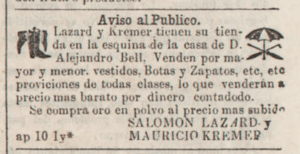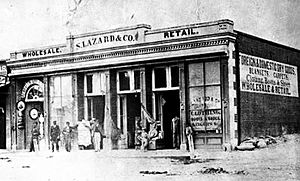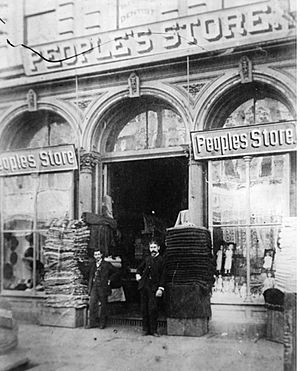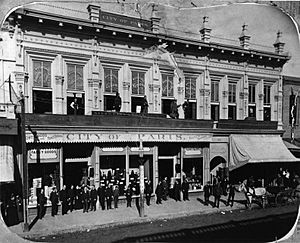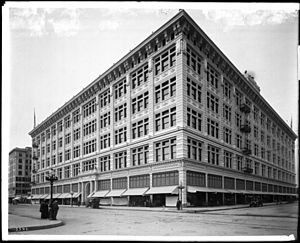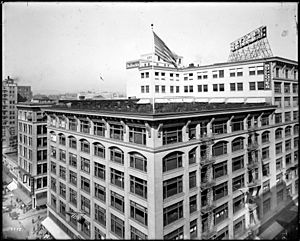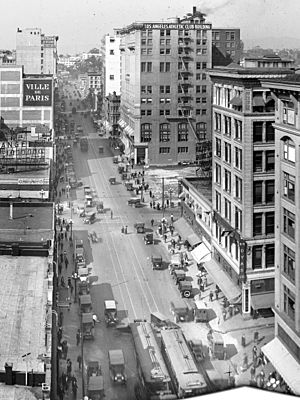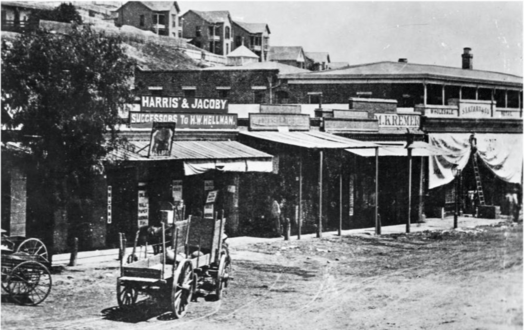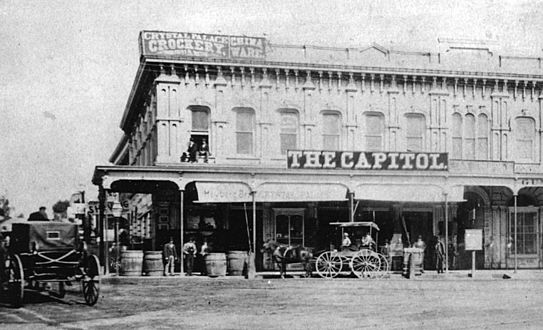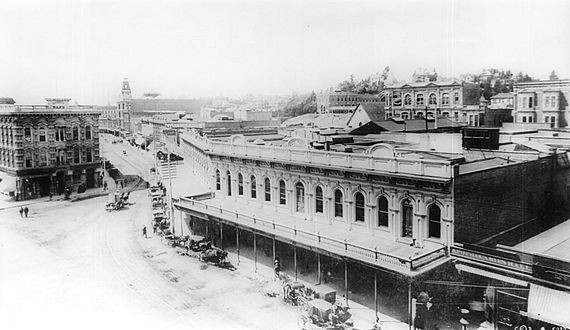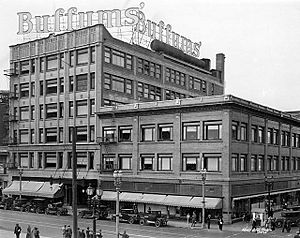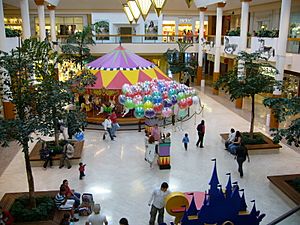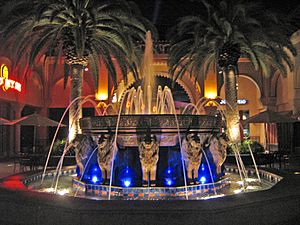History of retail in Southern California facts for kids
Southern California has a cool history of shopping! It all started way back in 1827 when a man named Jonathan Temple opened the very first dry goods store in Los Angeles. Back then, Los Angeles was just a small Mexican village.
As Los Angeles grew, more stores opened. These early shops sold things like clothes, fabrics, and household items. Over time, bigger stores started to appear. They moved from the old town center to new areas, especially along Broadway and Seventh Street. For about 50 years, these two streets were one of the biggest and busiest shopping areas in America!
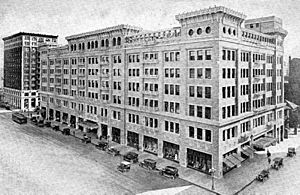
In the 1920s, department stores started opening smaller branches in areas like Hollywood and Mid-Wilshire. But the biggest change happened in the 1950s when huge shopping centers and malls began to pop up all over the suburbs. Soon, most people didn't need to go all the way to Downtown Los Angeles to shop.
By the 1990s, many of the famous local department store chains either closed down or became part of bigger companies like Macy's. Today, shopping in Southern California is a mix of different types of places, like big outdoor centers, outlet malls, and traditional malls. Online shopping has also become a huge part of how people buy things.
Contents
- How Shopping Started (1827-1870s)
- Broadway: A Shopping Hotspot
- Downtown Los Angeles: A Shopping Adventure
- First Suburban Shopping Areas
- 1950s-1980s: Malls Take Over
- The End of Local Chains
- Shopping Today
How Shopping Started (1827-1870s)
The very first dry goods store in Los Angeles was opened by Jonathan Temple in 1827. Los Angeles was a small Mexican village at that time.
Over the next few decades, more dry goods stores opened. Some of these, like Harris & Frank (started in 1856) and Desmond's (department store) (started in 1862), grew into big local chains that lasted for many years. These early stores slowly moved a few blocks south from the old Plaza area to streets like Temple, First, and Main. Some of them became the city's first department stores, such as the City of Paris, Jacoby Bros., Hamburger's, and Coulter's.
Early Shopping Blocks
-
Today, this corner is home to the Spring Street U.S. Courthouse, built in 1940.
A very important spot for early shopping was the northwest corner of Temple and Main streets. Several buildings stood here over time. The first two were key because they housed many fancy stores that later became famous in Los Angeles. Today, this spot is home to the Spring Street U.S. Courthouse.
- Old Downey Block (before 1871): This was the first building at the corner of Temple and Main. Stores like Harris & Jacoby (who later became Harris & Frank and Jacoby Bros.) and M. Kremer (who started the City of Paris) began here.
- Downey Block (1871–1910): This building replaced the Old Downey Block. Stores like Coulter's and Jacoby Bros. were located here.
Temple Block
Temple Block was a group of buildings built in 1858 and made bigger in 1871. It was located between Spring, Main, and Temple streets. Besides having many law offices, it was also important for shopping. Some fancy stores like Desmond's and Jacoby Bros. had their first homes here.
By the 1880s, most of the upscale stores had moved southwest. They gathered around First and Spring streets, which became the new main shopping area. This area was later torn down and is now the Civic Center, home to many government buildings.
Broadway: A Shopping Hotspot
Around 1905 to 1915, the big department stores started moving to Broadway between 3rd and 9th streets. They built huge stores that often took up almost an entire city block! The Broadway store led the way in 1896. Then came Hamburger's (which later became May Company California) in 1906, and Bullock's in 1907.

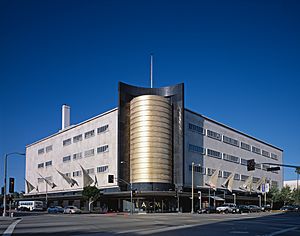
Starting in 1915, more upscale stores like J. W. Robinson's also moved west along Seventh Street. They went as far as Figueroa, where Barker Bros. built a massive store in 1926. Together, Broadway and Seventh Street created a very large shopping district in Downtown Los Angeles.
The four biggest department stores in Downtown L.A. alone were huge! Bullock's, The Broadway, May Co., and J. W. Robinson's combined had over three million square feet of space. That's as big as some of the largest malls today!
Table of department stores on Broadway and 7th streets This article is about the amazing history of big shops, called department stores, in Downtown Los Angeles. Imagine a time when these stores were the main places people went to shop, meet friends, and spend their day! Downtown LA had several famous shopping streets, like Spring Street, Broadway, and Seventh Street, each with its own special era of popularity. This list will take you on a journey through time, showing you where these stores were, when they opened, and what happened to them. It's like a treasure map of old shopping spots!
Downtown Los Angeles: A Shopping Adventure
Downtown Los Angeles was once the heart of shopping for the entire city. People would travel from all over to visit these grand department stores. These weren't just places to buy clothes or household items; they were huge, fancy buildings that often had restaurants, beauty salons, and even art exhibits! They were like early versions of today's shopping malls, but all under one roof in a single, impressive building.
Spring Street: Where It All Began
Spring Street was one of the very first popular shopping areas in Downtown LA, especially between the late 1800s and early 1900s. It was a bustling place where many famous stores first opened their doors.
- Coulter's: This store first opened on Spring Street in 1884. It was located at the corner of 2nd and Spring. Coulter's was a popular spot, but it moved to bigger and better locations several times as the city grew.
- Hamburger's: Another early giant, Hamburger's, started on Spring Street in 1888. This store would later become the famous May Company.
- Mullen & Bluett: This store opened in 1889. It was known for its clothing and moved to a new location on Broadway later on.
- Jacoby Bros.: Starting in 1891, Jacoby Bros. was another important store on Spring Street. Like many others, it moved to Broadway as that street became more popular for shopping.
- The Hub: Opened in 1896, The Hub was located near Court Street on Spring Street. It also moved to Broadway later. Many of these early Spring Street locations are now part of the City Hall area.
Broadway: The Golden Age of Shopping
Broadway became the most important shopping street in Downtown Los Angeles, especially from the late 1890s to the 1950s. It was lined with magnificent department stores, many of which are still standing today, though they are used for different purposes.
Broadway: From 2nd to 3rd Street
- Ville de Paris: This store, also known as A. Fusenot Co., opened on Broadway in 1893. It moved a few times and eventually became part of other stores.
- Coulter's: After its start on Spring Street, Coulter's had a large store on Broadway from 1905 to 1917. This building was huge, about 157,000 square feet! It was later torn down for a parking lot.
- Boston Dry Goods (J.W. Robinson Co.): This store, which would become the famous J.W. Robinson Co., opened on Broadway in 1895. It was a very important store that later moved to an even grander location on 7th Street.
- I. Magnin / Myer Siegel: These two stores shared a location on Broadway starting in 1899. Today, this building is used as a wedding chapel.
Broadway: From 3rd to 4th Street
- Coulter's: Before its larger store, Coulter's was also in the Homer Laughlin Building on Broadway from 1898 to 1905. This building is now home to the famous Grand Central Market.
- Jacoby Bros.: This store moved to Broadway in 1899 and stayed there for a long time, until 1935-1936. It was a large store, about 60,000 square feet. Today, parts of the building are used for independent shops.
- Ville de Paris: This store also moved to the Homer Laughlin Building in 1905, becoming part of the vibrant shopping scene there.
- J. J. Haggarty: Known as the "New York Store," J. J. Haggarty opened on Broadway in 1905. Only two stories of its original building remain today.
- J. M. Hale (Hale’s): This store opened in 1909. Like some other buildings from that era, its top floors have been removed, but retail shops still operate there.
Broadway: South of 4th Street
- The Broadway: This was one of the most iconic department stores in Los Angeles. Its first major location opened on the corner of 4th and Broadway in 1896. It was incredibly large, expanding to over 577,000 square feet by 1924! The building is now the Junipero Serra State Office Building.
- Bon Marché: This store was at 430 S. Broadway but closed in 1907.
- The Hub: After its Spring Street location, The Hub moved to 430 S. Broadway in 1907, taking over the former Bon Marché space.
- Myer Siegel: This store also had a location at 455 S. Broadway, which later became part of Fallas Paredes.
Broadway: From 5th to 6th Street
- Fifth Street Store (later Walker's): This store opened in 1905 at the corner of 5th and Broadway. It was a very large store, reaching over 278,000 square feet by 1917. The building later housed Ohrbach's.
- Ohrbach's: This store took over the former Walker's location.
- Silverwoods: Opened in 1904, Silverwoods was located at the corner of 6th and Broadway. It was a significant store, about 115,000 square feet by 1920. Today, the building is a jewelry mart.
Broadway: From 6th to 7th Street
- Jacoby Bros.: This store had another location at 605 S. Broadway from 1936 to 1938 before it closed down. The building later became a Zukor's and is now mixed-use.
- Central Department Store: This store was short-lived, operating from 1907 to 1908. Its location is now the site of the beautiful Los Angeles Theatre.
- Myer Siegel: This store also had a location at 617 S. Broadway, which was later demolished for the Los Angeles Theatre.
- Mullen & Bluett: After its Spring Street start, Mullen & Bluett moved to 610 S. Broadway in 1910 and stayed there until the 1960s. The building is now mixed-use.
- Desmond's: A well-known clothing store, Desmond's opened at 616 S. Broadway in 1924 and closed in 1972. The building was renovated in 2019 and now has offices, a restaurant, and a rooftop bar.
- Harris & Frank: This store had a location at 644 S. Broadway from 1947 to 1980.
- Bullock's: One of the most famous department stores, Bullock's opened its first Downtown LA location at the corner of 7th and Broadway in 1907. It grew to be enormous, covering most of the block by 1934 with over 800,000 square feet! This grand building is now the St. Vincents Jewelry Mart.
Broadway: From 7th to 8th Street
- F.W. Woolworth: This popular "five-and-dime" store opened at 719 S. Broadway in 1920. Today, a Ross Dress for Less is in its place.
- Reich and Lièvre: This store was located at 737-745 S. Broadway from 1917 to around 1927.
Broadway: From 8th to 9th Street
- Hamburger's (later May Company): This store, which started on Spring Street, opened its second and most famous location at the corner of 8th and Broadway in 1906. After 1925, it became the May Company. This store was truly massive, growing to over 1,000,000 square feet by 1930! It closed in 1986 and is now being renovated to become a tech campus.
Broadway: From 9th to 10th Street
- Blackstone's Department Store: Opened in 1917 at 901 S. Broadway, this building later became "The Famous" department store and is now used for residential apartments and retail shops.
- Eastern Columbia: This iconic Art Deco building at 849 S. Broadway opened in 1930. It was a department store until 1957 and is now a residential condominium building.
Seventh Street: The Modern Shopping District
Seventh Street became a major shopping area a bit later, starting around 1915. It was known for its more modern and upscale stores.
Seventh Street: Between Hill and Olive
- Ville de Paris (later B. H. Dyas): This store moved to 420 W. 7th Street in 1917. It closed in 1933, and the building is now part of the L.A. Jewelry Mart.
- Coulter's: After its many moves, Coulter's opened its fourth location at 500 W. 7th Street in 1917. It stayed here until 1938 before moving to the Miracle Mile area. The building is now mixed-use.
Seventh Street: Between Olive and Grand
- Haggarty's: This store opened at 520–530 W. 7th Street in 1917 and closed in 1963. The building has since been converted into apartments.
Seventh Street: Between Grand and Hope
- J. W. Robinson's: This store moved to its grandest location at 600 W. 7th Street in 1915. It was a huge store, expanding to over 623,000 square feet by 1923. It remained a major downtown landmark until it closed in 1993. The building is now mixed-use.
- Desmond's: Desmond's had a second location on 7th Street, opening in 1934 at 617 W. 7th Street. This location is now a Walgreens.
Seventh Street: Between Hope and Flower
- The Broadway (later Macy's): The Broadway moved its main downtown store to Broadway Plaza at 750 W. 7th Street in 1973. This location is still open today as a Macy's store!
- Desmond's: Before its second 7th Street location, Desmond's had an earlier store at 717 W. 7th Street from 1927 to 1934. This building is now a restaurant.
- Barker Bros.: This was a very large home furnishings store that opened its final downtown location at 818 W. 7th Street in 1926. It was an enormous building, about 1,000,000 square feet! It closed in 1984 and is now used for offices.
Seventh Street: Between Figueroa and Francisco
- Bullock's (later Macy's): After its long run on Broadway, Bullock's moved to the Seventh Market Place (now FIGat7th) at 735 S. Figueroa in 1986. It closed in 1996.
- May Company (later Macy's): The May Company also moved to the Seventh Market Place in 1986. It closed in 2009. Today, this area is a popular shopping center with stores like Target, Zara, Nordstrom Rack, and H&M.
Flower Street: Specialty Shops
Flower Street, especially between 7th and 8th, also had some important stores, often more specialized than the large department stores.
- Weatherby-Kayser: This shoe store opened at 715–9 S. Flower in 1925.
- Myer Siegel: This store had its fourth location at 733 S. Flower, opening in 1927.
- Parmelee-Dohrmann: This store specialized in homewares and opened at 741–7 S. Flower in 1927.
First Suburban Shopping Areas
In the first half of the 1900s, some towns outside of Los Angeles also grew into big shopping areas. Some of their local department stores, like Buffums in Long Beach and Harris Co. in San Bernardino, even became small chains after World War II.
Hollywood's Shopping Scene
Hollywood became the main suburban shopping area before World War II. It attracted branches of both local and national stores, from everyday shops to fancy ones. This happened between the late 1910s and late 1920s.
Hollywood Boulevard and nearby streets became a major shopping district. People could buy daily necessities, appliances, and also high-end clothes. This was partly because of the nearby film studios. Famous stores like Schwab's, Mullen & Bluett, I. Magnin, and Myer Siegel opened here. Even dime stores like F. W. Grand and Newberry's arrived.
A large independent store called Robertson's opened in 1923. In 1928, B. H. Dyas, a department store from Downtown Los Angeles, opened a huge building at Hollywood and Vine. This building is still a landmark today, known as the Broadway Hollywood Building. By 1930, Hollywood had over 300 stores!
However, Hollywood's shopping scene later faced competition from other areas. These included places along Wilshire Boulevard and especially Beverly Hills, where Saks Fifth Avenue opened a store in 1938. Beverly Hills soon became the top luxury shopping district outside of Downtown L.A.
Branches of Downtown Stores
In 1929, Bullock's and B. H. Dyas department stores built the first suburban branches. Bullock's opened in Mid-Wilshire, and B. H. Dyas in Hollywood. Other stores like Bullock's and Desmond's opened smaller, fancy stores in places like Westwood Village and Palm Springs. Sears also built several stores in the suburbs. Even with these new suburban stores, Downtown Los Angeles was still the giant of retail shopping in Southern California.
1950s-1980s: Malls Take Over
After World War II, suburban shopping really took off. Huge shopping centers like Crenshaw Center (1947), Lakewood Center (1952), and Valley Plaza (1951) opened. Valley Plaza even claimed to be the largest shopping center on the West Coast of the United States in the mid-1950s!
Bullock's built a series of "Fashion Squares," starting with Santa Ana Fashion Square in 1958. Other big stores like Broadway and Robinson's also supported new suburban centers. By the 1960s, most shoppers in the Los Angeles area didn't go to Downtown Los Angeles anymore. It was too far for many, and parking was harder than in the suburbs.
Downtown Broadway continued to be a busy shopping area, but from the 1970s, it became more focused on immigrant Latin American and local Hispanic shoppers. It offered many specialty shops, like those for quinceañera and wedding dresses.
More and more regional malls were built. The downtown areas of older suburbs like Long Beach and Santa Ana lost their role as major shopping districts. However, some built enclosed malls, like Plaza Pasadena and Santa Monica Place. Beverly Hills kept its status as the top luxury shopping area.
During this time, discount department stores and membership stores also became very popular. Many of these, like The Akron, Fedco, Mervyn's, and Zody's, were based in Los Angeles.
The End of Local Chains
In the 1990s, a big change happened. Through a series of business deals, the four main Los Angeles-based department stores – Bullock's, The Broadway, Robinson's, and May Company – along with Bullocks Wilshire and I. Magnin, all became part of Macy's. Macy's itself later became part of Federated Department Stores (now called Macy's Inc.). These famous local stores were either renamed Macy's, became Bloomingdales, or were closed or sold.
For example, in 1988, Macy's bought Bullock's and I. Magnin. Later, in 1995, Macy's also bought The Broadway chain. Macy's then changed the names of most Broadway and Bullock's stores to Macy's.
Also, in 1993, May Department Stores combined its May Company and Robinson's chains into one called Robinsons-May. But in 2005, Federated took over May, and Robinsons-May stores were also changed to Macy's, closed, or became Bloomingdales.
During this time, national discount stores like Walmart and Target became very popular. Some malls even had only discount stores as their main shops. The local discount store chains eventually closed down.
Shopping Today
New types of shopping centers became popular. Large "power centers" with many big discount stores appeared. Some older malls were even torn down to make way for these new centers. Strip malls also continued to be popular.
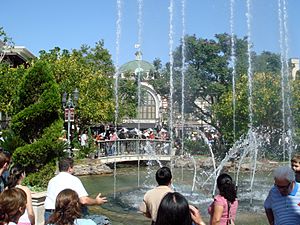
Downtown Burbank and Third Street Promenade in Santa Monica became successful again. Outdoor, pedestrian-friendly places like The Grove at Farmer's Market and Westfield Century City also thrived. Newer types of centers, like lifestyle centers such as Irvine Spectrum Center and outlet malls like The Citadel, were built. Many of the biggest traditional enclosed shopping malls, like South Coast Plaza and Los Cerritos Center, are still very popular today.
The old shopping districts in suburban downtowns, like Santa Ana and Pasadena, have often changed. They are now more about entertainment and arts, with outdoor dining and unique, artistic shops.
Today, there are very few department store chains based in Southern California. Most are discount retailers that focus on the Hispanic market, like National Stores/Fallas Paredes and Curacao.


